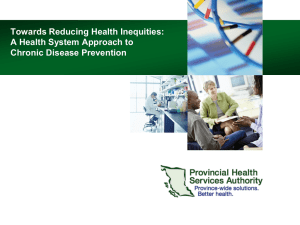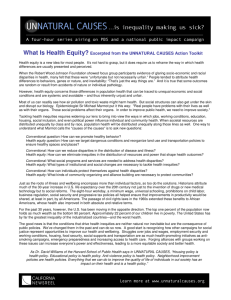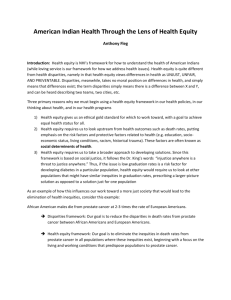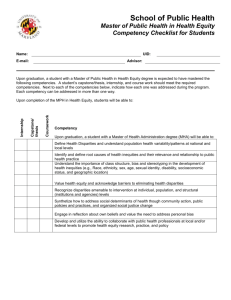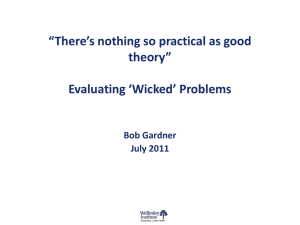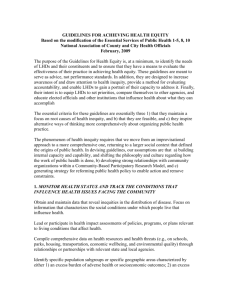Towards Reducing Health Inequities
advertisement
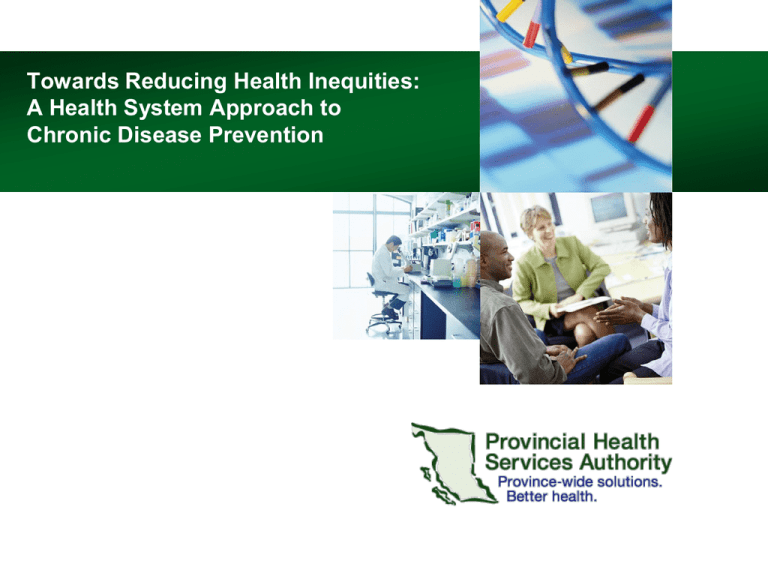
Towards Reducing Health Inequities: A Health System Approach to Chronic Disease Prevention Acknowledgements Project Manager Meredith Woermke (PHSA Population & Public Health) Project Steering Committee: Paola Ardiles, Chair (BC Mental Health & Addiction Services) Lydia Drasic (PHSA Population & Public Health) Carole Gillam (Vancouver Coastal Health Primary Care) Dr. Andrew Kmetic (PHSA Population & Public Health) Dr. John Millar (PHSA Population & Public Health) Ann Pederson (BC Women’s Hospital & Health Centre and the BC Centre of Excellence for Women’s Health) Meredith Woermke (PHSA Population & Public Health) Final Edits and Content Review: Tannis Cheadle (PHSA Population & Public Health) 2 Project Advisory Group Sherry Bar Victoria Lee Lex Bass Paul Beckett Eric Kowalski Gail Butt Veronic Clair Dominic Fung Joan Geber Caryl Harper Julie Kerr Ted Bruce Trevor Hancock Mel Krajden Joanne Mills Judi Mussenden Sylvia Robinson Helena Swinkels Lesley Varley Fiona Walks Laurie Woodland Kelly McQuillen Donna Murphy-Burke 3 Presentation Outline • Project overview and approach • Introduction: making the case for reducing health inequities • Equity in Health Care Framework • Barriers Identified by Project Working Groups • Five key Recommendations for Action • Everyone has a role! • Questions and Comments 4 Reducing Health Inequities: A Health System Approach to Chronic Disease Prevention Project Project Goal: • To collaboratively identify the actions the health system can take towards reducing health inequities. Project Activities: • Overall Approach: engaging health authority, government and community • Project Advisory Group • Workshop aimed at public health practitioners, researchers & policy makers • Environmental scan of activities in BC aimed to reduce inequities/Literature Reviews • Strategy & Partnership Building Forum • Three Specific Population Working groups • Final Discussion Paper 5 Health Inequities - Definition • Differences in health status among population groups that are deemed to be unfair, unjust, or preventable, as well as socially produced and systematic in their distribution across the population (Commission on Social Determinants of Health, 2007) • Inequities generally exist along two major gradients: socioeconomic status and geographic status (e.g., urban vs. rural location) • Inequities also appear as differences across: ethnicity, gender, age, and disabilities 6 Introduction: making the case Health inequities: • contribute to poor health within BC • associated with significant and wide-reaching health, social and economic costs • cost BC an estimated $2.6 billion annually (Health Officers Council of BC, 2008) Differences in prevalence of chronic disease (and life expectancy) among various groups including: • children and families living in poverty • people with mental health and substance use issues • Aboriginal people • immigrants and refugees 7 LE0 for BC Total Population (2001-2005) by Local Health Area (LHA) Life Expectancy at Birth Stikine Telegraph Creek 70.2 79.9 - 80.2 74.5 - 76.1 80.4 - 80.9 76.8 - 77.9 81.0 - 81.6 78.2 - 79.1 81.9 - 83.0 79.2 - 79.8 83.5 - 85.4 Fort Nelson Snow Country Queen Charlotte Nisga'a Prince RupertTerraceUpper Skeena Prince Rupert Queen Charlotte Kitimat Smithers Nechako Kitimat Kitimat Central Coast Burns Lake Central Coast Central Coast Central Coast Central CoastBella Coola Valley Central Coast Peace River North Peace River South Prince George North Vancouver Quesnel Vancouver Island North Vancouver Island North Cariboo-Chilcotin Vancouver Island WestCampbell River Vancouver Island WestCampbell River 100 Mile HouseNorth Thompson CourtenayPowell River Lillooet Sunshine CoastHowe Sound Alberni Kamloops Maple RidgeSouth Cariboo Golden Revelstoke Nanaimo Salmon Arm Agassiz-Harrison Lake Cowichan Merritt Enderby MissionHope Vernon Sooke Princeton Arrow Lakes Saanich Chilliwack Keremeos Kootenay LakeWindermere Kettle Valley Grand Forks NelsonKimberley Trail CrestonCranbrook 8 Fernie (Data source: BC Health Data Warehouse and BC STATS) City Centre North East Westside MidtownBurnaby Richmond Richmond Delta Delta Inequities and Chronic Disease Source: Health Inequities in BC Discussion Paper, 2008 Released by Health Officers Council of BC 9 How can the health system respond? • The Health System has an important role to play in achieving more equitable health outcomes for populations through the design, organization, and management of its programs and services (Health Council of Canada, 2010b) • Equity in health care refers to the distribution of health resources; that they are allocated proportionately to need as well as the provision of services that meet the values of cultural beliefs of distinct system users (Hopkins 2009; Waters, 2000) 10 Target specific populations or address common barriers/solutions? Focus: Three underserved populations were identified: • immigrants • refugees • individuals transitioning into and out of the corrections system 11 Equity in Health Care Framework Availability Whether health promotion, disease prevention and curative services are provided within the health system Accessibility Extent to which the health system is designed and delivered in such a way that users can navigate the system, identify, and access services. Gender Acceptability Patient-centered care Extent to which services are provided in a way that meets the needs of distinct cultural, linguistic, ethnic, and social groups (Dis)Ability Language The Health System Availability Accessibility Housing Poverty (Adapted from: Baum, 2009; Bowen, 2001) 12 Acceptability Barriers to Health Care (Identified by Project Working Groups) Barriers Affecting the Availability of Services: • Limited attachment to health care providers for underserved populations due to stigma, cultural and language barriers. • Unavailability of extended health care services, due to financial barriers and minimal access to language interpretation services. Barrier Affecting the Acceptability of Services: • Lack of culturally competent health services; limited understanding of how stigma and social exclusion affects the health care of underserved populations. 13 Barriers Identified by Working Groups (continued) Barriers Affecting the Accessibility of Services: • Complexity of the health care system leads to navigation/health literacy challenges. • Geographic barriers and operational barriers limit the accessibility of health services and programs. • Discontinuity and limited partnerships between health services and other services (community/settlement/social). • Broader SDOH (including transportation, housing and child care) which significantly impact the extent to which individuals are able to use and navigate the health system. 14 Five key recommendations for action 1. Develop health equity targets and plans in consultation with communities and community members and actively monitor and measure their impact on health inequities by: Building on current initiatives to utilize health equity assessment tools to coordinate the design, implementation and evaluation of ongoing and future policies, programs, and services 15 Recommendations (continued) 2. Improve health literacy by: increasing the capacity of health care providers to communicate effectively with health system users and to respond to their diverse needs supporting opportunities to increase the capacity of underserved or inappropriately served groups to better access, understand, communicate, evaluate, and act on health information and services 16 Recommendations (continued) 3. Increase equitable access to prevention and curative services for underserved populations by: Enhancing the availability of community-based primary health care services Building on existing specialized, population-focused primary health care services 17 Recommendations (continued) 4. Develop intersectoral collaborative and knowledge exchange mechanisms to inform existing programs and the development of new health promotion, primary prevention, and self-management support programs that are culturally competent by: Promoting communication and coordination between the health system and stakeholders, including community members, for dialogue and joint problem solving 18 Recommendations (continued) 5. Increase the capacity of the health system to better serve the needs of BC’s culturally and linguistically diverse population by: Ensuring that policies, programs, and services are culturally competent Providing skill-based cultural competency training opportunities for health system providers to improve communication with users and to respond to their diverse needs 19 What did the project accomplish? • Shared information on current BC initiatives and recent policy directions that support the health system’s role in reducing HI • Identified issues within the health system in BC that may be creating HI contributing to chronic diseases • Improved understanding of what the health system can do in terms of the design and delivery of services, with emphasis on prevention – Outlined 5 recommendations for action to address the barriers faced by underserved populations – Identified 27 specific opportunities for relevant actions the health system/actors can take – Identified relevant equity tools, resources, frameworks and local activities and initiatives to build upon • Identified opportunities for further dialogue and action 20 Final Message: Everyone has a role Senior Health Executives • make a strategic commitment for action • provide organizations/staff with support to incorporate the types of strategies identified into health policy, planning and service delivery Health Program or Service Managers • contribute to the development & measurement of health equity targets, • influence and lead health literacy efforts, and encourage cultural competency among their staff Front Line Health Care Providers • increase competencies to provide culturally competent services • support patients/families in their efforts to better understand health info & services 21 Questions & Comments For more information please visit: http://www.phsa.ca/HealthProfessionals/Population-Public Health/Centres-ForPopulation-Public-Health/RHIProject.htm 22
